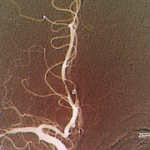Behçet’s disease involves the eyes in 25–75% of patients and progresses to blindness if untreated. Uveitis is the dominant ophthalmologic manifestation of disease, but hypopyon, retinal vasculitis, vascular occlusion and optic neuritis may also occur. Sensorineural hearing loss occurs in 20–30% of patients and is typically mild.6
Neurosarcoidosis affects up to 15% of patients with sarcoidosis. Eye involvement occurs in 25–60% of patients and may manifest as conjunctivitis, anterior uveitis, retinal vasculitis, orbital inflammation, lacrimal gland enlargement or optic neuropathy. Sensorineural hearing loss is rare, but may also occur.7
When to Consider Susac Syndrome?
Susac syndrome should come to mind when a patient has a triad of encephalopathy (CNS dysfunction), visual loss (branch retinal artery occlusions) and sensorineural hearing loss.
CNS dysfunction: “New-onset headache can hint at Susac syndrome, although this [symptom] is nonspecific. Focal neurological signs, behavioral changes and encephalopathy should prompt consideration of this diagnosis,” Dr. Furer said.
Typical CNS findings include cerebrospinal fluid pleocytosis (50% of patients), elevated protein (80% of patients) and multiple hyperintense lesions on brain MRI with pathognomonic snowball lesions in the corpus callosum, as well as other regions.8
Visual loss: Branch retinal artery occlusions may be asymptomatic or present as a loss of visual acuity, flashing or blindness.
“Fundoscopy, optical coherence tomography and fluorescein angiography are key clinical and diagnostic tools that we should use in every patient considered for Susac syndrome. Branch retinal artery occlusions are found in 99% of patients, so fluorescein angiography is an obligatory test, even in the absence of visual symptoms,” Dr. Furer said.
Sensorineural hearing loss may present as hearing loss, tinnitus and/or vertigo. Dr. Furer said, “Audiogram should be performed in all patients, even in the absence of symptoms.”
A Challenging Diagnosis
Susac syndrome has a wide range of clinical variability, especially when it comes to neurologic symptoms. The full clinical triad is rare at disease onset and seen in less than 20% of patients, but it does develop in 85% of patients during the disease course. The natural history of the disease is also variable. It’s monocyclic in 50% of patients, polycyclic in 40%, and 10% of patients have a chronic-continuous form.
“All these factors lead to diagnostic delay and potential irreversible damage that we all want to prevent,” Dr. Furer said.
Diagnostic criteria for Susac syndrome were published by the European Susac Consortium (EuSaC) in 2016.9

